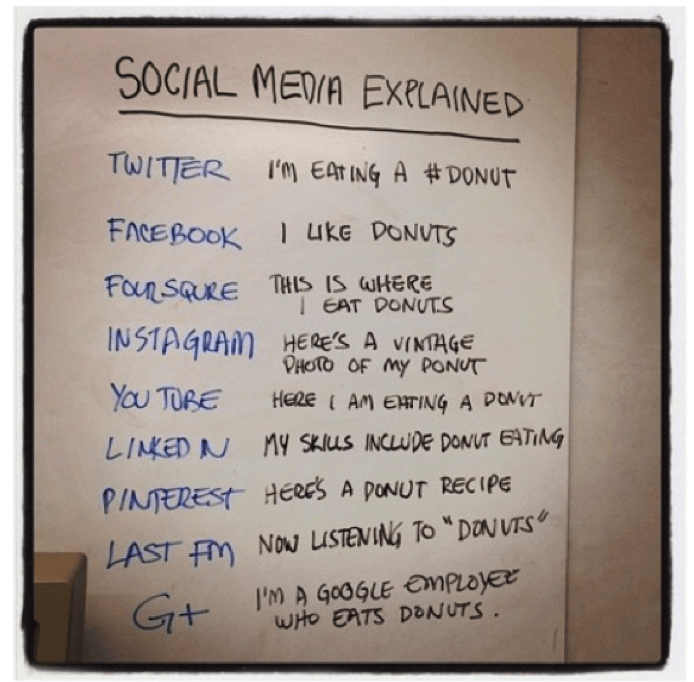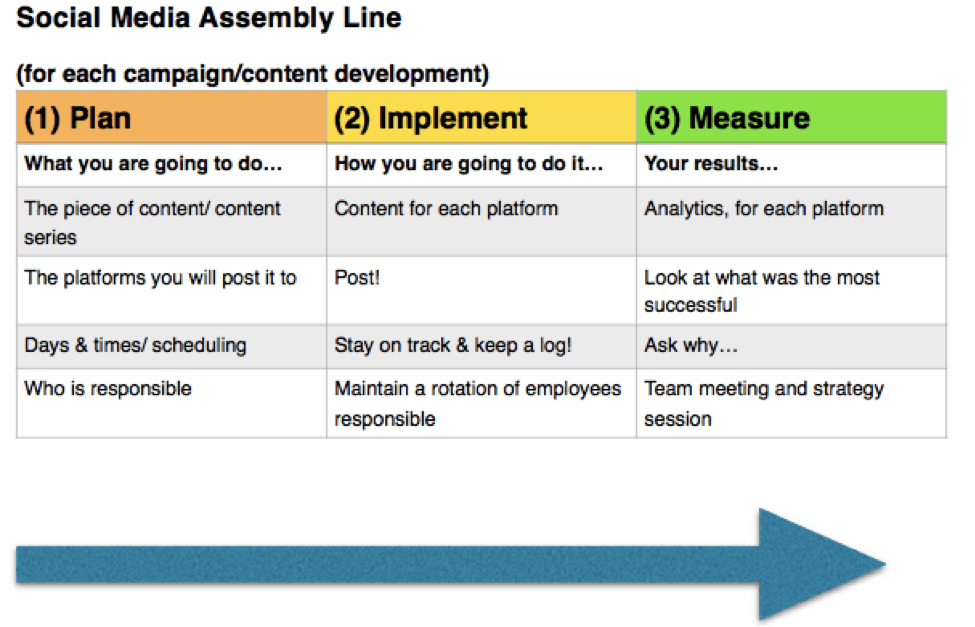How to Create a Winning Social Media Assembly Line for a Smoother Strategy
“There has to be a more effective way” is something you might have found yourself saying over the past year as you plan out and implement all of your social media marketing, and you’re not the only one. With so many social platforms and roles and responsibilities it takes to manage them, it can feel a little bit daunting at times and you might be questioning whether there is a more effective way. The best strategy for success is to plan ahead. As a social media management company, we believe a social media “assembly line” should do the trick for most small businesses.
Keep in mind that to make this work smoothly you might need a team of employees who work on social media—that way you can divide and conquer. It is also important to keep in mind that different social platforms have different perspectives for content. I like the image below by SocialRank because it shows that even if you are posting the same content to multiple accounts there is going to be a different way you address it and ultimately a different purpose for posting:
When you’re developing your social media strategy, you are going to go through three phases, what BufferSocial calls “The Wheel of Social Media strategy”, and it includes (1) Plan, (2), Implement, and (3) Measure.
Within these three stages you are going to have several other tasks and goals, all of which have priority and should be done in a relatively consistent order. Keeping this general idea in mind, below I have constructed the Social Media Assembly Line to help you conceptualize the tasks in each phase, and we will discuss each phase in more detail afterwards.
Step 1: Plan
This is the beginning of your assembly line. You actually want to sit down at the drawing board once you have decided upon a campaign or have developed a piece of content that you are ready to take to social media. Once you have the piece of content or campaign you are going to want to decide where you will be posting and how your content will be best served. As the image in the intro suggests, you can in fact take one piece of content and distribute it widely across all platforms, however, you need to keep in mind the different perspectives that those platforms have.
After you have decided what and where, you can devise a schedule. How many times will you post this particular piece of content? It is going to depend on the time of content and purpose. If it is for an event, you might want to post more frequently than a blog post with a visiting authoritative writer. Planning this out and actually marking it on a schedule is going to be essential for the next step, implementing.
Lastly, you are going to want to plan who is going to be responsible. Most companies do not have one person responsible for social media. This is great as it takes the load off of one person; however, you want to make sure that you are not getting your wires crossed. You do not want the working content form posted on Twitter, or people posting to Facebook twice in one day. Devising a plan for who is responsible for what in this assembly line is essential.
Step 2: Implement
Once you have developed a plan, the actual implementing is fairly smooth. You will make considerations for whatever platforms you have decided to share your content on and then tailor your content to each before you post. Remember, as the screenshot above shows there are different forms and styles you will want to follow for positing.
You are going to want to stay on track with the schedules you have designed keeping in mind specific days and times. A helpful tip is to have a whiteboard in your office where you can visibly see the schedule and check each post off as it happens. You can also set calendar alerts on your computer calendar so that you get notifications.
As we discussed in the “planning” section, you are going to want to hold employees responsible for their delegated posting duties, and check back in with them to see how the initial responses are from your audience, you don’t have to wait until the next step to start getting a feel for how it is going.
Step 3: Measure
The last and possibly the most important step in your social media marketing assembly line is to measure. This means looking at all of your traffic on analytics and figuring out which forms and platforms got the best response. This is really helpful in designing your next social media marketing strategy and knowing how to launch forward with content design.
That being said, different content is going to have different effects on different social media platforms. In other words, just because your last post was more popular on Twitter than Instagram does not mean next time you should eliminate posting to Instagram. Obviously certain content forms are going to do better certain places, and this isn’t a mark that you should shift your entire strategy. Pay attention, though, because maybe there is a creative and different approach to take with the content that is not performing as well on certain platforms, in which case repurposing you main content for certain platforms might be an effective strategy. Below is a sample screenshot:
Divide and Conquer
Something that has come up a few times in this post in the notion of planning ahead and diving the workload into manageable pieces. If you think of this work as an assembly line, you may also want to think of the staff you have on-board as assembly line workers. You do not want everyone doing the same thing at the same stage, so always make sure you have a “divide and conquer” mentality to get things done more efficiently. One way to think about this mentality is to have step 1, 2, and 3 be a teams of their own, and within each team, divide up the work further.
How do you feel about conceptualizing social media marketing as an assembly line? Do you feel like this might help your business stay on track and improve? Let us know in the comments section below.











